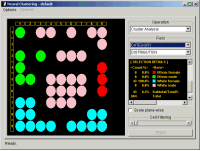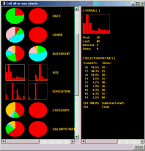Analytic CRM and Database Marketing
Database marketing is an important part of Analytic CRM.
In a plain language, database marketing is a marketing technique
that utilizes customer databases. Formally,
database marketing is a form of one-to-one direct marketing
in which databases of customers (or potential customers) are used to
generate personalized communications in promoting products or services.
Due to the richness of customer information,
database marketing places emphasis on the use of analytic methods in selecting
or targeting customers for marketing purposes.
Database marketing may include;
- Customer profiling
- Customer segmentation
- Customer scoring
- Customer retention
- Cross-selling
- Up-selling
|
Customer Information used in Analytic CRM and Database Marketing
Database marketing techniques described here are well-suited
to companies with a large number of direct customers
or data providers with a large number of potential customers.
Customer information that can be used in analytical database marketing
may include the followings;
- Demographic variables describe characteristics of populations and
include age, gender, race, education, occupation, income, religion,
marital status, family size, children, home ownership, socioeconomic status, and so on.
- Geographic variables include various classification of geographic
areas, for example, zip code, state, country, region, climate, population,
and other geographical census data. Note that this information can come from
national census data.
- Psychographic variables describe life style, personality, values, attitudes,
and so on.
- Behavioral variables include product usage rate and end, brand royalty,
benefit sought, decision making units, ready-to-buy stage, and so on.
This information can be extremely useful for marketing purposes.
- Past business history includes various business statistics on customers.
This provides essential business indicators and therefore is very important information.
In addition, RFM information can be included in the list;
-
Recency: Customers purchased recently tend to buy again.
-
Frequency: Customers purchased frequently tend to buy again.
-
Monetary Value: Customers purchased most monetary values tend to buy again.
...... for more about RFM Marketing and Scoring.
|
Analytic Database Marketing Techniques
A prominent feature of database marketing is that there is readily available
rich information about customers. Customer databases can become information gold mines.
Analyzing them can lead to new marketing opportunities, thereby deepening
customer relationships. Common analytic techniques used in database marketing
are profiling, segmentation, and scoring. They are described in the subsequent
sections.
Customer Profiling
Understating customers is very important in any business.
Profiling customers can lead to better understanding about
customers. For example, credit/insurance risk levels,
marketing responsiveness, churn risk level, and so on.
Although customer profiles may be invaluable for conducting businesses,
obtaining them may not come easily. The main problem is with
the size of customer information. There many dozens or hundreds of
customer data fields. Without advanced software tools,
analyzing them and extracting
most relevant information is a non-trivial task.
CMSR Hotspot Profiling is an advanced
tool for analyzing complex customer information and extract
most relevant information.
Customer Database Segmentation
People with similar attributes tend to exhibit similar tendencies
in purchasing patterns. This leads to development of various segmentation
techniques. Segmentation is performed in a way that keeps customers
of a segment to have similar attributes (or profiles), while customers
in different segments have dissimilar attributes.
The intra-group homogeneity and the fact that people with similar attributes
are likely to respond somewhat similarly to a given marketing strategy
lead to segmentation marketing strategies customized for
specific segments. The following figures show CMSR
Neural Clustering Segmentation tools.
The figures clearly show that similar customers are clustered within
or nearby segments.


Database Marketing Methods
Database marketing techniques can be applied to different marketing
approaches. The following sections describe various database marketing methods.
Direct Marketing - Mails, Emails, SMS, Telemarketing
Direct marketing is a form of marketing in which marketers promote
products directly to customers. Common forms of direct marketing
include postal mails, emails and telemarketing. The first two send
catalogs to customers. The first one involves sending catalogs to
customers through postal mails, a costly marketing method. The last
involves more cost than other two. The cost includes not only
phone calls but also costly human labor works.
The problem with direct marketing is with the fact that
success rates of direct marketing is very low. For example, some survey
suggests that national average of catalog sales success ratio is about 2%!
With such success ratio, selling low profit margin products through direct
marketing may not be feasible.
Analytic methods that can select customers who are more likely to buy
products are needed. The following techniques can be used in selecting
customers;
- Customer profiling
- Customer segmentation
- Customer scoring
These techniques can reduce marketing cost by eliminating customer groups
who are unlikely to place orders. The techniques are extensively described in
Direct Mail Marketing and
RFM Marketing.
Details can be found from the linked pages.
Cross-selling and Basket analysis
Cross-selling is to sell other products to existing customers.
To increase the success rate, other products tend to be
co-products or related products. For example, a customer who bought a pocket MP3 player
will be highly interested in buying rechargeable batteries along with a charger.
The following chart shows customer purchasing behaviors;

Cells in red color indicate that there is positive relationship between two products.
That is, when customers buy one product, they tend to buy the other product as well.
Cells in blue color indicate the opposite. When customers buy one product, they tend
to not buy the other product. Brightness of cells indicates the relative strength of
relationships. The chart shows that the following product pairs have strong
positive relationship;
- Product P ~ Product O
- Product P ~ Product F
- Product O ~ Product F
Also notice that most product pairs shows negative relationship (in blue).
Knowing negative relationship can prevent from wasteful marketing efforts!
The strongest pairs as follows;
- Product E ~ Product H
- Product G ~ Product J
- Product G ~ Product H
Up-selling
Up-selling refers to selling more expensive products or services to existing users
of the same type items. The normally involves upgrades or replacements to more
expensive products or services. It is noted that up-selling is a bit tricky business.
Selling more expensive products to customers who cannot afford is no business.
Rather it can irritate customers and lead to defection to rival providers.
(See next section "Customer Retention"). So careful sensible customer targeting is
needed! The following methods can be applied;
- Customer profiling
Profiles of customers who are using higher-cost-version products are developed.
The profiles are then used to identify customers who are in the profiles but still using
lower-cost-version products. For obvious reasons, they are candidates for
up-selling marketing efforts.
- Customer scoring
Customers are given scores 0 and 1 depending on product versions they are using,
i.e., for low-cost-version users are given 0 and the others 1. With the scores,
a neural network predictive model is developed. The model is then applied to
customer database records to compute predicted scores. Customers scoring high
but still using low-cost-version products are targets for up-sell marketing.
This method is similar to that of
Direct Mail Marketing and Customer Scoring.
For more information, read the linked page.
- Customer segmentation
Segmenting customers may produce segments with many customers using higher-cost-version
products. Customers using lower-cost-version in those segments can be good candidates
for up-sell marketing.
Customer Retention
In many industries, customer churn is a big problem. For example,
telecommunication industry has very high customer churn rate,
especially in wireless services.
It is noted that acquiring a new customer is several times more expensive than
keeping an existing one. Therefore retaining customers is a very important
management issue.
For obvious reasons, the most important strategy in customer retention is
to identify groups that are likely to leave (potentially to rival providers)
through performing retention (alternatively defection) rate analysis.
Once they are identified, preventive measures can be developed and
actions can be followed to prevent defections.
The following techniques can be used to
identify customer groups of defection risk;
|



